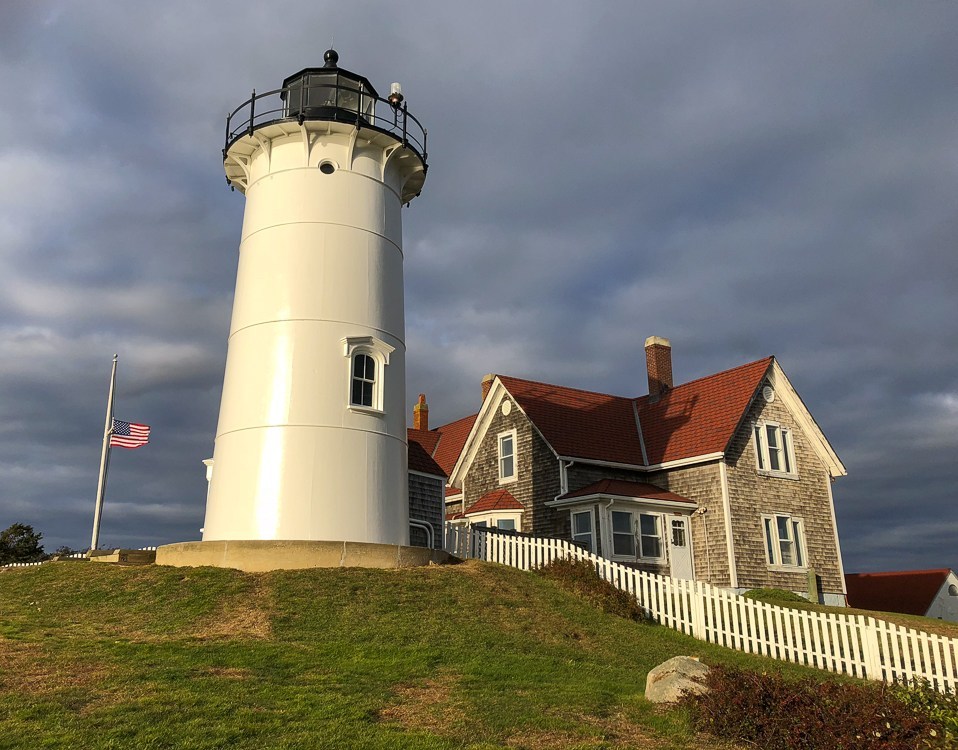Return to Flotilla 11-2's Home Page.

LIGHTHOUSE HISTORY
In the 19th Century, construction of lighthouses along the Atlantic coast was critical for the safety of merchant mariners transporting goods and materials by sea. In 1828, the U.S. government purchased four acres on Nobska (Nobsque) Point for $160 and the first lighthouse on the site, a wooden structure that incorporated keeper’s quarters, was constructed at a cost of $2,249.
In 1841, the first Fresnel lens (pronounced “frennel”) was installed. Named for French physicist Augustin Fresnel, these massive glass lenses are cleverly designed to gather light from a source, concentrate it and emit a beam with a range of many nautical miles. Peter Dagget, the lightkeeper in 1845, reported using ten oil lamps which consumed 339 gallons annually, carried by hand up to the light room.
The wooden light structure operated for 38 years and was replaced in 1876 by the present, 40-foot tall cast iron lighthouse, which was manufactured in Chelsea, Massachusetts. A separate house for the lightkeeper was also built that year. The Fresnel lens was upgraded to a larger, 4th order lens in 1888; this lens is still in place today and may be viewed during a lighthouse tour.
Improvements were periodically added to the facility, including construction of a brick oil house, a paint locker and, in 1875, a fog bell tower. In 1905 a second keeper’s dwelling was added; a 1 ½ story, wood frame structure built at a cost of $6,000. By 1919, electricity had come to Cape Cod and the light was electrified with a 150-watt bulb, making oil obsolete.
During the 1930’s and 40’s, technological advances were incorporated. A radio tower was erected in 1937, used for triangulation bearings with Cleveland Ledge and Butler Flats in New Bedford. The fog bell was replaced in 1948 by a compressed air diaphragm horn mounted on a 125-foot tall radio tower.
KEEPERS AND STEWARDS
The Nobska Point Lighthouse was operated by the U.S. Lighthouse Service for 111 years, from 1828 until 1939, when the Service was merged with the U.S. Coast Guard. By 1949, the Woods Hole Coast Guard also had responsibility for 23 other manned lighthouses as well as for eight lightships; Nantucket, Handkerchief, Pollack Rip, Stone Horse, Cross Rip, Vineyard, Hens and Chickens and Bretton Reef.
The last civilian light keeper at Nobska Point Lighthouse was Joseph Hindley, who retired in 1972. He was replaced by active duty Coast Guard enlisted personnel. In 1985, the light was automated, eliminating the need for full-time keepers.
As of April 25th, 2016, the Coast Guard awarded the stewardship of the Nobska property to the Town of Falmouth. A non-profit organization, Friends of Nobska Light now manages all aspects of the lighthouse, which includes tours, as well as planning for the creation of a museum.
To learn more
Friends of Nobska Light Website
Facebook: Friends of Nobska Light.
email: Friends of Nobska